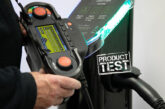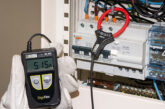
Gary Fisher tells us how he got on with the FLIR C2 Compact Thermal Imaging System.
You could easily mistake the FLIR C2 model for a mobile phone. It is so small and light, fitting in your top pocket.
The camera has a hard cushioned case to protect it from heavy impact on site. However, it really doesn’t feel like the kind of kit you can get away with dropping too often, so you can protect it further by tying it to yourself using the lanyard loop.
It is a very easy device to get to grips with. The thermal imaging can be viewed via the three-inch touch screen, where you can access all the features through the menu button. Around the outer case are the on off and shutter buttons, which, due to their rubber surrounds, can be slightly difficult to depress during operation.
The picture quality is pretty amazing, considering how small this camera is. The C2 features FLIR’s MSX image enhancement technology, this helps ensure, you can see objects and heat areas extremely clear with plenty of detail in the photo, which helps identify the areas that need attention quickly.
I only have a couple of minor gripes. I do have to keep it charged up almost every night, as the C2 does not hold charge for too long. I’m used to this with a lot of gadgets I own now, but it would be annoying if you need the tool but haven’t had time to charge it.
Pros
● Easy to use
● Light-weight and compact to carry
● Picture quality is great
● Lightweight
Cons
● On/Off buttons awkward
● Screen could get damaged easily in transit
● Requires regular charging
Also, the price may put off a few in the trade. No thermal imaging devices are cheap, but a good cordless drill would cost you more. I’d say this is probably priced for the serious professional, the kind of contractor who regularly maintains installations in industrial and heavy commercial environments. I would imagine that an in-house electrician, in a factory for example, would find the ability to quickly survey multiple installations, then record and report findings particularly appealing.
The main things I have used this camera for are domestic consumer units. One of the main reasons we now have metal consumer units is because of the fires which can occur within due to loose connections building up heat points. This thermal camera could be just the thing to prevent this. When doing an estimate you could simply point it at the clients consumer unit and there you could show your client clear proof that there is a possible danger that needs to be addressed. However, as I mentioned before, I really think this device would prove most useful in heavier commercial and industrial settings, diagnosing problems on larger, high voltage installations.








